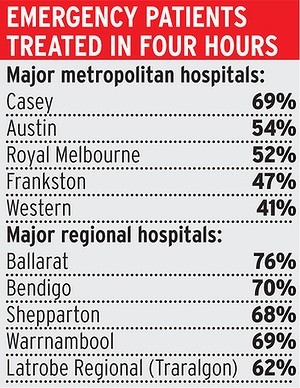FOOTSCRAY’S Western Hospital is treating just 41 per cent of emergency patients within four hours, making it one of the worst-performing hospitals in Australia on new federal targets.
A report released by the National Health Performance Authority on Friday shows the result placed Western Hospital in the lowest 10 per cent of major metropolitan hospitals around Australia for 2011-12.
The worst-performing major metropolitan hospital was the Princess Alexandra Hospital in Brisbane, which treated 33 per cent of patients on time, and the best was Perth’s Fremantle Hospital at 74 per cent.
Federal government targets introduced in January require states to treat more emergency patients within four hours.
They include a target this year for Victorian emergency departments to treat 70 per cent of patients within this time, or risk more than $12 million in bonus funding.
By 2015, 90 per cent of Australian patients will be required to be admitted to a bed or discharged home within four hours, but the federal government has set interim deadlines that vary between states so they improve on past performance.
Across Victoria last financial year, hospitals treated 65 per cent of emergency patients within time. New South Wales was among the worst performers (60 per cent) and Western Australia, which introduced the four-hour rule in 2009, was the best (79 per cent).
The report showed that Casey Hospital in Berwick was among the best performing major metropolitan hospitals in Australia, treating 69 per cent of emergency patients within four hours.
Australia’s best performing medium-sized hospital was the Williamstown Hospital, which treated 93 per cent of patients within four hours.
Western Health chief executive Alex Cockram said Western Hospital had ”substantial challenges” to overcome to meet four-hour emergency targets, including a high demand for services, but work was under way to lift performance.
With a $107 million reduction in federal funding due to hit Victorian hospitals this financial year, including a $6.6 million cut at Western Health, Associate Professor Cockram said: ”The latest funding and budget cuts will further compound this challenge”.
Australian Medical Association Victoria president Stephen Parnis said hospitals that treated a high number of older patients with often complex problems would have the greatest difficulty meeting four-hour emergency targets.
”It will always be easier for hospitals that have younger populations and a higher proportion of patients discharged rather than admitted to make targets,” he said.
”I am extremely sceptical that we will be able to meet these targets … we are continually being hamstrung by cutbacks to services.”
National Health Performance Authority chief executive Diane Watson said the report assigned hospitals to categories based on their size to ensure comparison was fair, with the aim of identifying hospitals that needed improvement and those from whom others could learn.
The report is based on an analysis of about 5.9 million presentations to 134 public hospital emergency departments.







